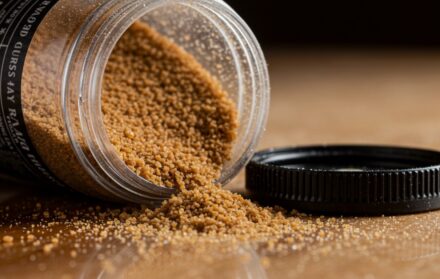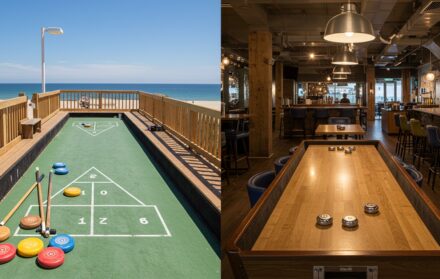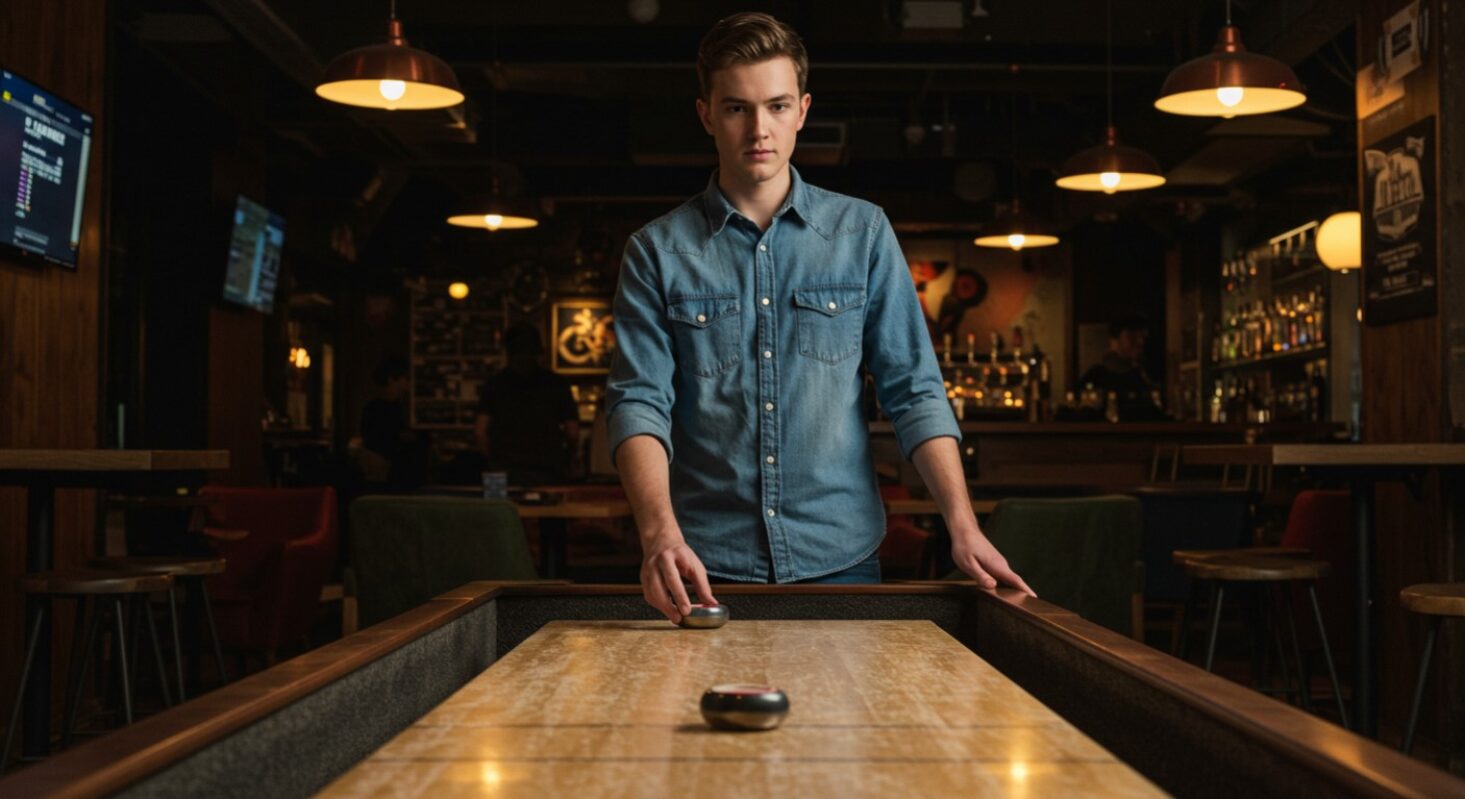
What are the Basic Rules of Shuffleboard?
Shuffleboard is one of those rare games that manages to be simple enough for beginners to pick up in minutes, yet strategic enough to keep experienced players hooked for years. Whether you have seen long shuffleboard tables in trendy pubs or watched families sliding discs across a cruise ship deck, the appeal is universal.
At its heart, shuffleboard is about skill, precision, and a touch of luck. But to really enjoy it, you need to understand the basic rules of shuffleboard. This guide explains the objectives, equipment, scoring systems, and the differences between the two main versions of the game: table shuffleboard and deck shuffleboard.
The Objective of Shuffleboard
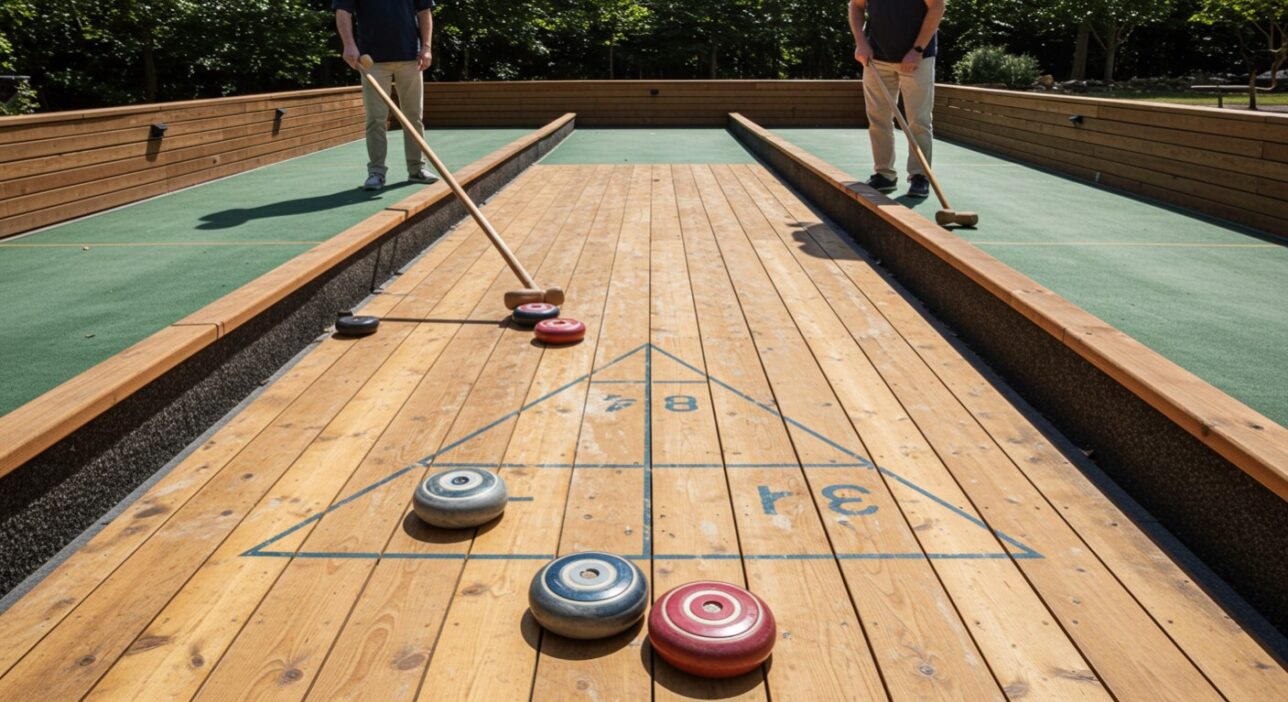
The aim of shuffleboard is straightforward: slide your puck or disc so that it lands in a scoring zone while trying to knock your opponent’s pieces out of play. Victory comes from accumulating points over a series of turns or rounds.
-
In table shuffleboard, points are scored based on how far down the table your puck stops.
-
In deck shuffleboard, points are scored by landing discs inside marked areas of a triangular court.
Despite the variations, the shared objective is simple: outscore your opponent by combining accuracy, touch, and tactical play.
Shuffleboard Equipment Overview
Before diving into the rules, it helps to understand the main equipment used in both versions.
-
Pucks (weights/discs): In table shuffleboard, players use four pucks each, usually coloured red and blue. Deck shuffleboard uses larger discs in the same two colours.
-
Playing surface: Table shuffleboard is played on polished wooden tables, often 12–22 feet long. Deck shuffleboard takes place on a marked court, typically on cruise ships or outdoor courts.
-
Shuffleboard wax (sand): A fine material sprinkled on tables to reduce friction and allow smooth gliding.
-
Cues: Long sticks used only in deck shuffleboard to push discs.
Table Shuffleboard: The Basic Rules
Setting Up the Game
-
Played with two players (singles) or four players (doubles).
-
Each side has four pucks, distinguished by colour.
-
Players take turns sliding pucks down the table from one end, alternating shots.
-
A coin toss or agreement usually decides who goes first.
How to Play Each Turn
-
The puck must be slid from behind the foul line without being lifted.
-
Each player alternates shots until all pucks are used.
-
Pucks must stay on the playing surface to count.
Scoring in Table Shuffleboard
-
Points are awarded depending on which scoring zone the puck rests in:
-
1 point for pucks in the first zone.
-
2 points for pucks in the middle zone.
-
3 points for pucks in the farthest zone.
-
-
A hanger (puck hanging slightly over the edge without falling) often scores 4 points.
-
Only the pucks furthest down the table for each side count in a round.
-
Tactics include knocking your opponent’s pucks out while protecting your own.
Winning a Game
-
Casual games often play to 15 or 21 points.
-
Tournament formats may use frames or higher point limits.
Deck Shuffleboard: The Basic Rules
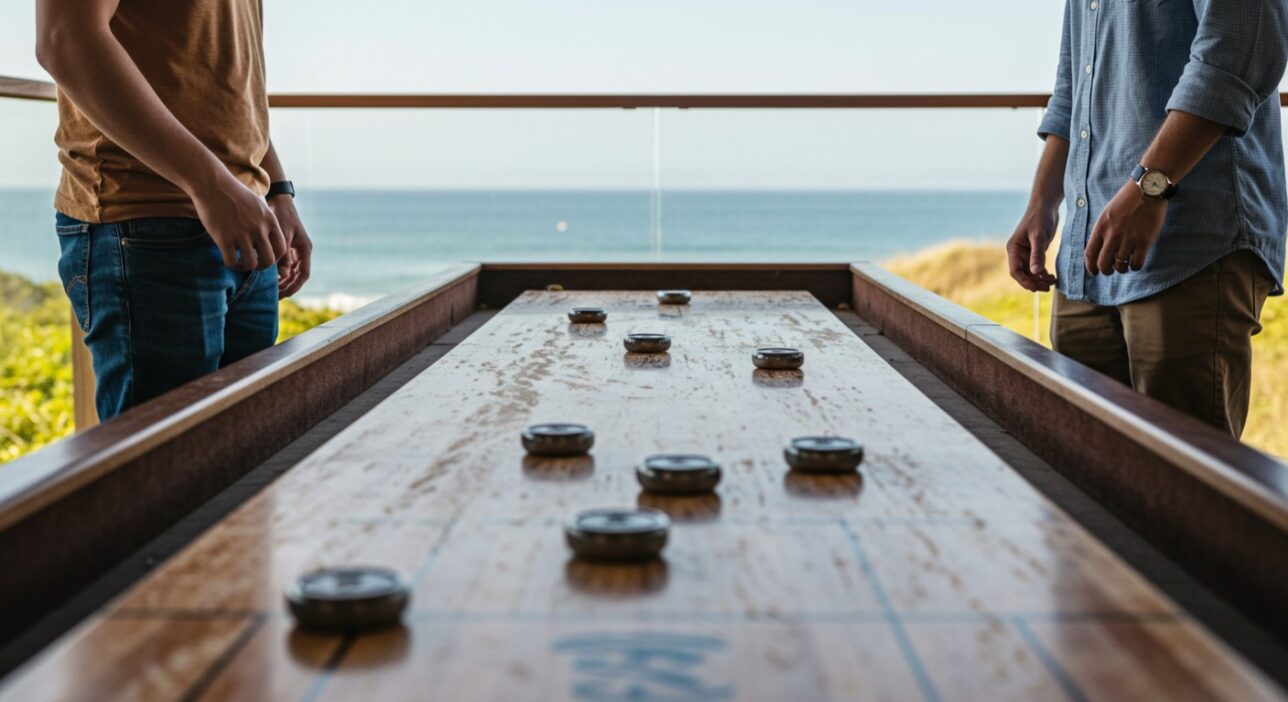
Court Layout
-
Played on a long court marked with triangles at either end.
-
Each triangle is divided into scoring areas: 10, 8, and 7 points.
-
The bottom section of the triangle has a “10 off” zone, which subtracts points if occupied.
How to Play Each Turn
-
Players use cues to slide discs from behind a baseline.
-
Turns alternate until all discs are played.
-
Discs must cross a line to be valid, but not leave the court.
Scoring in Deck Shuffleboard
-
Discs resting fully inside scoring areas count for their respective values.
-
Discs touching lines usually do not count.
-
Landing in the 10 off zone deducts ten points from your score.
-
As in table shuffleboard, knocking opponents’ discs out is allowed.
Winning a Game
-
Standard competitive games are played to 75 points or a set number of rounds (often 8 or 10).
-
Casual games may use shorter scoring formats.
Side-by-Side Rules Comparison
| Rule Area | Table Shuffleboard | Deck Shuffleboard |
|---|---|---|
| Playing Surface | Long polished wooden table (12–22 feet). | Painted court with triangles and scoring zones. |
| Equipment | Pucks (weights), shuffleboard wax. | Discs, long cues to slide them. |
| Players | 2 (singles) or 4 (doubles). | 2 (singles) or 4 (doubles). |
| Turns | Slide pucks by hand, alternating turns. | Slide discs with cues, alternating turns. |
| Scoring Zones | 1, 2, 3 points; hanger = 4 points. | 7, 8, 10 points; “10 off” zone deducts points. |
| Winning Formats | First to 15 or 21 points; frame play. | First to 75 points or best of rounds. |
| Tactics | Knock opponent’s pucks out, block zones. | Knock opponent’s discs out, avoid penalties. |
Common Rules Shared Between Versions
-
Turns must alternate between players.
-
Only pucks/discs remaining in valid scoring areas after a round are counted.
-
Players cannot touch or move pucks/discs until scoring is confirmed.
-
Fouls include:
-
Crossing the foul line before shooting.
-
Using two hands or lifting the puck/disc.
-
Interfering with discs mid-play.
-
Variations and House Rules
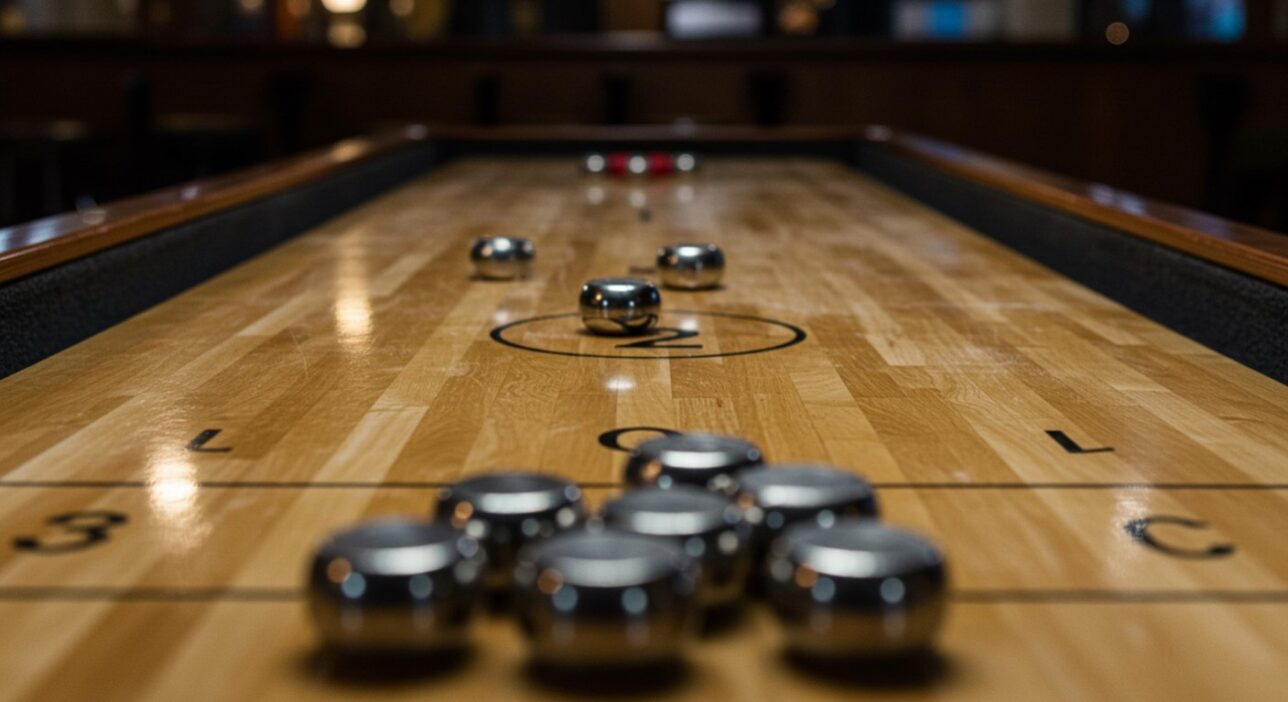
One of shuffleboard’s charms is its flexibility. Many venues apply their own versions of the rules:
-
Pub tables in the UK: Often shorter than full tournament tables, with simplified scoring.
-
Family versions: Shorter games to 10 points or reduced scoring areas.
-
Tournament variations: Strict enforcement of scoring lines and fouls.
-
Cruise ship rules: May shorten games to keep play moving when multiple groups want a turn.
Beginner Mistakes to Avoid
Learning the rules is only part of the journey. Many beginners fall into the same traps:
-
Over-sliding pucks/discs: Using too much force and sending them off the end.
-
Ignoring scoring lines: A puck not fully past a line may not count.
-
Forgetting turns: Players sometimes shoot out of order.
-
Not knowing house rules: Always ask the venue which scoring system they use.
Why Shuffleboard Rules Matter
Shuffleboard might look casual, but the rules keep it fair and strategic. Without them, the game risks descending into chaos. By following the basics, players can:
-
Compete on equal footing.
-
Build tactical awareness (whether to attack or defend).
-
Transition smoothly from a friendly pub game to a more competitive setting.
Understanding the rules makes shuffleboard more fun and rewarding, while opening the door to advanced strategies and variations.
Conclusion: Mastering the Basic Rules of Shuffleboard

The basic rules of shuffleboard are easy to learn but full of depth. Whether you are sliding pucks on a polished table in a London pub or pushing discs across a cruise ship deck, the principles are the same: accuracy, control, and a touch of cunning.
By learning how turns work, how points are scored, and what formats are used, you can enjoy shuffleboard the way it has been played for centuries. Once you master the fundamentals, you will find endless enjoyment in experimenting with tactics, entering friendly competitions, and even trying new variations.
Shuffleboard’s enduring appeal lies in its blend of simplicity and strategy. With the basic rules of shuffleboard in hand, you are ready to step up, take your shot, and join a game that has entertained players across the world for generations.


